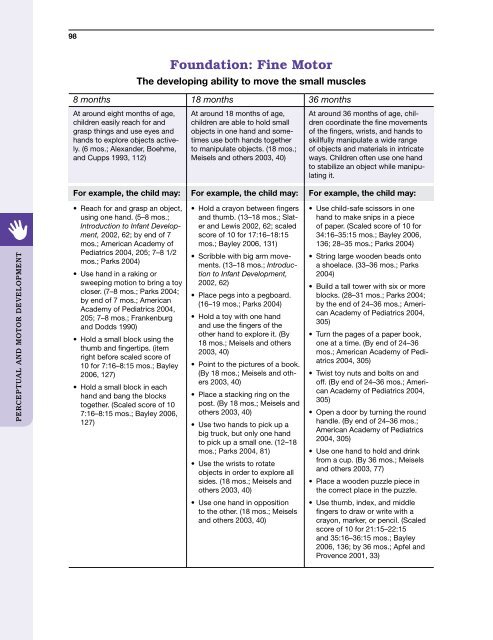Infant Toddler Learning & Development Foundations
Infant Toddler Learning & Development Foundations
Infant Toddler Learning & Development Foundations
You also want an ePaper? Increase the reach of your titles
YUMPU automatically turns print PDFs into web optimized ePapers that Google loves.
PERCEPTUAL AND MOTOR DEVELOPMENT<br />
98<br />
8 months<br />
At around eight months of age,<br />
children easily reach for and<br />
grasp things and use eyes and<br />
hands to explore objects actively.<br />
(6 mos.; Alexander, Boehme,<br />
and Cupps 1993, 112)<br />
For example, the child may:<br />
• Reach for and grasp an object,<br />
using one hand. (5–8 mos.;<br />
Introduction to <strong>Infant</strong> <strong>Development</strong>,<br />
2002, 62; by end of 7<br />
mos.; American Academy of<br />
Pediatrics 2004, 205; 7–8 1/2<br />
mos.; Parks 2004)<br />
• Use hand in a raking or<br />
sweeping motion to bring a toy<br />
closer. (7–8 mos.; Parks 2004;<br />
by end of 7 mos.; American<br />
Academy of Pediatrics 2004,<br />
205; 7–8 mos.; Frankenburg<br />
and Dodds 1990)<br />
• Hold a small block using the<br />
thumb and fingertips. (item<br />
right before scaled score of<br />
10 for 7:16–8:15 mos.; Bayley<br />
2006, 127)<br />
• Hold a small block in each<br />
hand and bang the blocks<br />
together. (Scaled score of 10<br />
7:16–8:15 mos.; Bayley 2006,<br />
127)<br />
Foundation: Fine Motor<br />
The developing ability to move the small muscles<br />
18 months<br />
At around 18 months of age,<br />
children are able to hold small<br />
objects in one hand and sometimes<br />
use both hands together<br />
to manipulate objects. (18 mos.;<br />
Meisels and others 2003, 40)<br />
For example, the child may:<br />
• Hold a crayon between fingers<br />
and thumb. (13–18 mos.; Slater<br />
and Lewis 2002, 62; scaled<br />
score of 10 for 17:16–18:15<br />
mos.; Bayley 2006, 131)<br />
• Scribble with big arm movements.<br />
(13–18 mos.; Introduction<br />
to <strong>Infant</strong> <strong>Development</strong>,<br />
2002, 62)<br />
• Place pegs into a pegboard.<br />
(16–19 mos.; Parks 2004)<br />
• Hold a toy with one hand<br />
and use the fingers of the<br />
other hand to explore it. (By<br />
18 mos.; Meisels and others<br />
2003, 40)<br />
• Point to the pictures of a book.<br />
(By 18 mos.; Meisels and others<br />
2003, 40)<br />
• Place a stacking ring on the<br />
post. (By 18 mos.; Meisels and<br />
others 2003, 40)<br />
• Use two hands to pick up a<br />
big truck, but only one hand<br />
to pick up a small one. (12–18<br />
mos.; Parks 2004, 81)<br />
• Use the wrists to rotate<br />
objects in order to explore all<br />
sides. (18 mos.; Meisels and<br />
others 2003, 40)<br />
• Use one hand in opposition<br />
to the other. (18 mos.; Meisels<br />
and others 2003, 40)<br />
36 months<br />
At around 36 months of age, children<br />
coordinate the fine movements<br />
of the fingers, wrists, and hands to<br />
skillfully manipulate a wide range<br />
of objects and materials in intricate<br />
ways. Children often use one hand<br />
to stabilize an object while manipulating<br />
it.<br />
For example, the child may:<br />
• Use child-safe scissors in one<br />
hand to make snips in a piece<br />
of paper. (Scaled score of 10 for<br />
34:16–35:15 mos.; Bayley 2006,<br />
136; 28–35 mos.; Parks 2004)<br />
• String large wooden beads onto<br />
a shoelace. (33–36 mos.; Parks<br />
2004)<br />
• Build a tall tower with six or more<br />
blocks. (28–31 mos.; Parks 2004;<br />
by the end of 24–36 mos.; American<br />
Academy of Pediatrics 2004,<br />
305)<br />
• Turn the pages of a paper book,<br />
one at a time. (By end of 24–36<br />
mos.; American Academy of Pediatrics<br />
2004, 305)<br />
• Twist toy nuts and bolts on and<br />
off. (By end of 24–36 mos.; American<br />
Academy of Pediatrics 2004,<br />
305)<br />
• Open a door by turning the round<br />
handle. (By end of 24–36 mos.;<br />
American Academy of Pediatrics<br />
2004, 305)<br />
• Use one hand to hold and drink<br />
from a cup. (By 36 mos.; Meisels<br />
and others 2003, 77)<br />
• Place a wooden puzzle piece in<br />
the correct place in the puzzle.<br />
• Use thumb, index, and middle<br />
fingers to draw or write with a<br />
crayon, marker, or pencil. (Scaled<br />
score of 10 for 21:15–22:15<br />
and 35:16–36:15 mos.; Bayley<br />
2006, 136; by 36 mos.; Apfel and<br />
Provence 2001, 33)
















